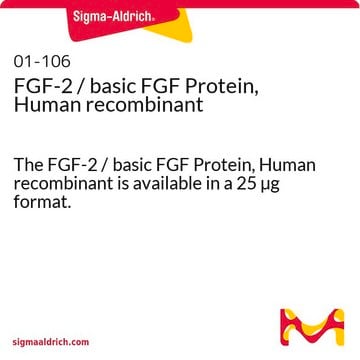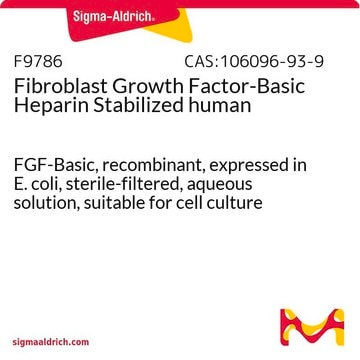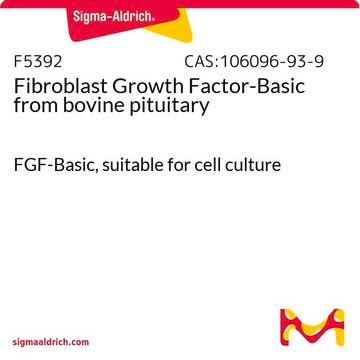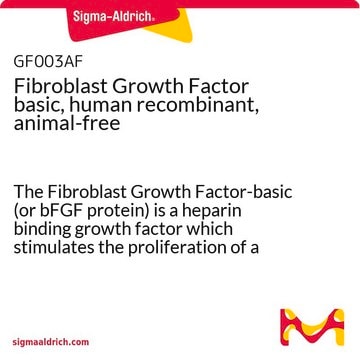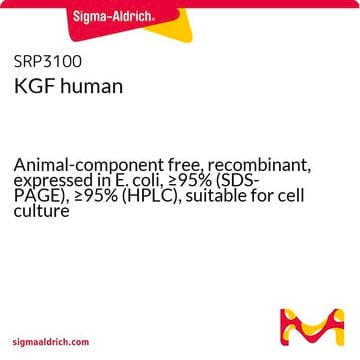SRP3043
FGF-basic human
Animal-component free, recombinant, expressed in E. coli, ≥95% (SDS-PAGE), ≥95% (HPLC), suitable for cell culture
Sinonimo/i:
Catabolin, Endogenous Pyrogen (EP), Leukocyte Endogenous Mediator (LEM), Lymphocyte-activating factor (LAF), Mononuclear Cell Factor (MCF)
Scegli un formato
CHF 451.00
Scegli un formato
About This Item
CHF 451.00
Prodotti consigliati
Origine biologica
human
Ricombinante
expressed in E. coli
Saggio
≥95% (HPLC)
≥95% (SDS-PAGE)
Stato
lyophilized
Potenza
≥1x10^7 units/mg
PM
17.2 kDa
Confezionamento
pkg of 50 μg
tecniche
cell culture | mammalian: suitable
Impurezze
<0.1 EU/μg endotoxin, tested
Colore
white to off-white
N° accesso UniProt
Condizioni di spedizione
wet ice
Temperatura di conservazione
−20°C
Informazioni sul gene
human ... FGF2(2247)
1 of 4
Questo articolo | SRP3038 | SRP3100 | SRP3039 |
|---|---|---|---|
| technique(s) cell culture | mammalian: suitable | technique(s) cell culture | mammalian: suitable | technique(s) cell culture | mammalian: suitable | technique(s) cell culture | mammalian: suitable |
| biological source human | biological source human | biological source human | biological source human |
| assay ≥95% (HPLC), ≥95% (SDS-PAGE) | assay ≥95% (HPLC), ≥95% (SDS-PAGE) | assay ≥95% (HPLC), ≥95% (SDS-PAGE) | assay ≥95% (HPLC), ≥95% (SDS-PAGE) |
| form lyophilized | form lyophilized | form lyophilized | form lyophilized |
| storage temp. −20°C | storage temp. −20°C | storage temp. −20°C | storage temp. −20°C |
Descrizione generale
Applicazioni
Azioni biochim/fisiol
Sequenza
Stato fisico
Ricostituzione
Codice della classe di stoccaggio
11 - Combustible Solids
Classe di pericolosità dell'acqua (WGK)
WGK 3
Punto d’infiammabilità (°F)
Not applicable
Punto d’infiammabilità (°C)
Not applicable
Scegli una delle versioni più recenti:
Certificati d'analisi (COA)
Non trovi la versione di tuo interesse?
Se hai bisogno di una versione specifica, puoi cercare il certificato tramite il numero di lotto.
Possiedi già questo prodotto?
I documenti relativi ai prodotti acquistati recentemente sono disponibili nell’Archivio dei documenti.
I clienti hanno visto anche
Articoli
Discover answers to your frequently asked questions about animal component-free, xenobiotic-free, and chemically defined media and reagents for cell culture.
Fibroblast growth factors in cell culture and various growth factors for your research
Active Filters
Il team dei nostri ricercatori vanta grande esperienza in tutte le aree della ricerca quali Life Science, scienza dei materiali, sintesi chimica, cromatografia, discipline analitiche, ecc..
Contatta l'Assistenza Tecnica.
